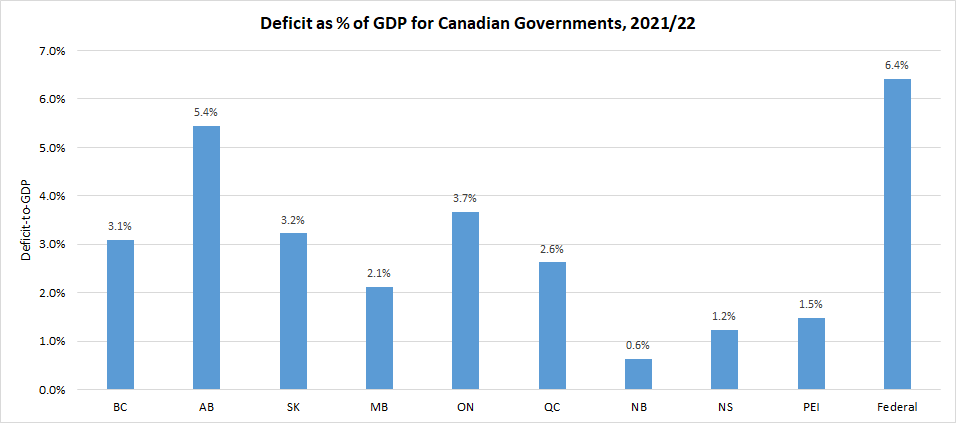2021 budgets establish uncertain future for government finances in Canada

Obviously, the response to the pandemic has taken a large toll on government finances across Canada. This year’s budget season saw lots of spending and red ink, with little concern for the long-term health of government finances. This blog post summarizes the key takeaways from key budgets across the country at both the provincial and federal levels.
After running a $354.2 billion federal budget deficit last year, the Trudeau government forecasts a $154.7 billion deficit in 2021/22 and further deficits of at least $30 billion for another four years afterwards. Debt accumulation has increased substantially and the country’s net debt-to-GDP ratio is projected to reach 55.3 per cent by the end of 2021/22. Federal program spending in 2021/22 has grown by more than 40 per cent since 2019/20 and nominal interest payments on federal debt are expected to nearly double by 2025, despite low interest rates. There’s no timeline for a balanced budget despite a vague promise from the prime minister in December to “absolutely” balance the budget again at some point.
British Columbia’s provincial budget includes a $9.7 billion operating deficit this year, up from the $8.1 billion deficit in 2020/21. Net debt (total debt minus financial assets) will reach a forecasted $94.1 billion in three years and the debt-to-GDP ratio will nearly double from pre-COVID levels at 27.3 per cent by 2023/24. Program spending will continue to grow throughout the fiscal outlook with increased spending on infrastructure, health care and childcare playing a prominent role. The Horgan government did not include a plan to return to balanced budgets, but the finance minister noted it would outline a detailed plan next year.
The Alberta budget projects a $18.2 billion deficit (2021/22) with sizable deficits in the following two years. Net debt will reach a projected $102.1 billion by 2023/24. The Kenney government no longer plans to balance the budget in its first term, but says such a plan will be re-established post-COVID. Fiscal policy will be guided by two additional rules—net debt should be no greater than 30 per cent of the economy and per-person spending will be aligned with the other large provinces. COVID-related spending is to be reined in over the next three years. Finally, the budget included spending reductions (in line with the government’s pre-pandemic fiscal plan) and no new taxes.
Ontario’s budget contained a projected $33.1 billion deficit for 2021/22, down modestly from last year’s historic $38.5 billion deficit. The province’s net debt-to-GDP ratio has climbed to 48.8 per cent and deficits are expected through 2028/29. Despite a vague commitment to budget balance in 2029/30—a commitment that would require nearly two more full terms in government—the Ford government failed to present any plan to balance the budget. The deficit is expected to shrink over the next few years as COVID-related spending is reduced, but there’s still a $20 billion deficit projected for 2023/24. Like its predecessors, the Ford government hopes that revenue growth will exceed spending growth, eventually leading to a balanced budget.
Nova Scotia’s budget projects a deficit of $585 million, but most concerning is the province’s rapidly increasing debt. Fuelled by the deficit and high capital spending, the province will add $1.3 billion to its net debt this year, following a $1.5 billion increase last year. In total, net debt is projected to increase by nearly 40 per cent in just five years. The province has a plan to return to a balanced budget, with a surplus projected in 2024/25. However, this budget delayed spending cuts to future years after an upcoming election.
Prince Edward Island’s budget presents a similar plan with large increases to debt fuelled by deficits and capital spending. This budget continued a track record of annual increases in government spending, which leaves P.E.I. with the highest level of per-person program spending in Canada. The government projects a balanced budget in 2024/25, but this plan, which projects increased government spending each year, relies on economic growth.
In contrast, New Brunswick’s budget projects a more stable fiscal position. The Higgs government has largely resisted new spending programs. As a result, the province forecasts a $245 million deficit. New Brunswick has the smallest deficit (as a share of the economy) and the smallest increase to net debt (on a per-person basis) among the provinces. Despite this relatively strong footing, the budget does not tackle longer-term challenges such as a high tax burden and poor investment record.

The table below compares estimates for the 2021/22 fiscal year on several items such as the deficit-to-GDP, debt-to-GDP, program spending, interest costs per person and timelines for balanced budgets. Of note, every province (except Alberta) has increased real per-capita spending by at least 5 per cent from pre-pandemic levels. The earliest timeline for a balanced budget among all governments is three years from now (in 2024/25) for both Nova Scotia and P.E.I. Four jurisdictions refrained from specifying any balanced budget date, while Manitoba and Ontario aim to achieve it in roughly 10 years.
| Budget Season Summary, 2021/22 Projections | ||||||
|---|---|---|---|---|---|---|
| Deficit to GDP | Net Debt to GDP | Interest costs per person ($) | Program spending per person ($) | % change in program spending since 2019 | Year of next balanced budget | |
| BC | 3.1% | 22.9% | 534 | 12,462 | 10.1% | No date given |
| AB | 5.4% | 24.5% | 621 | 13,296 | 0.7% | No date given |
| SK | 3.2% | 21.7% | 631 | 13,654 | 8.2% | 2026/27 |
| MB | 2.1% | 39.9% | 713 | 13,226 | 13.8% | 2028/29 |
| ON | 3.7% | 48.8% | 880 | 11,600 | 8.2% | 2029/30 |
| QC | 2.6% | 45.5% | 997 | 13,552 | 6.2% | 2027/28 |
| NB | 0.6% | 36.4% | 835 | 12,717 | 5.5% | No date given |
| NS | 1.2% | 37.9% | 723 | 11,967 | 7.0% | 2024/25 |
| PEI | 1.5% | 34.9% | 789 | 14,677 | 11.8% | 2024/25 |
| Federal | 6.4% | 55.3% | 575 | 12,697 | 32.8% | No date given |
Large deficits and high levels of spending were a common theme for all Canadians governments this budget season. Continued debt accumulation after the pandemic is over, and the potential for rising interest rates, will place government finances in a precarious position moving forward. Simply put, there are big questions about the sustainability of finances across Canada over the longer-term.
Authors:
Subscribe to the Fraser Institute
Get the latest news from the Fraser Institute on the latest research studies, news and events.

